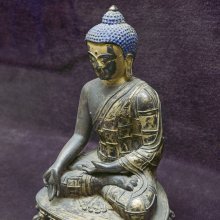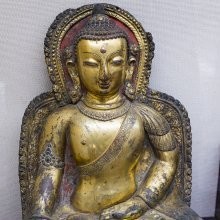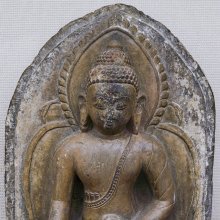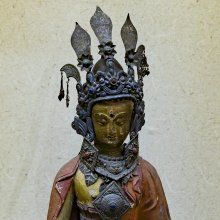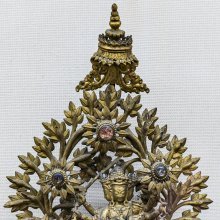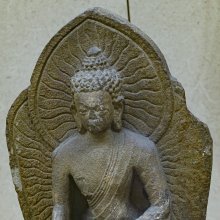Ratnasambhava, Ratnasaṃbhava: 9 definitions
Introduction:
Ratnasambhava means something in Buddhism, Pali, Hinduism, Sanskrit. If you want to know the exact meaning, history, etymology or English translation of this term then check out the descriptions on this page. Add your comment or reference to a book if you want to contribute to this summary article.
Images (photo gallery)
(+52 more images available)
In Buddhism
Tibetan Buddhism (Vajrayana or tantric Buddhism)
Source: Wisdom Library: MañjuśrīnāmasaṃgītiRatnasambhava (रत्नसम्भव) is one of the five Tathāgatas appearing in the Vajradhātu-mahāmaṇḍala, according to the Nāmamantrārthāvalokinī v5.29. The Nāmamantrārthāvalokinī (literally, ‘an explanation of the nāma-mantras’) is a commentary (ṭīkā) on the 8th century Mañjuśrīnāmasaṃgīti. His name can also be spelled as Ratnasaṃbhava (रत्नसंभव).
Ratnasambhava is a name of Mañjuśrī (the embodiement of non-dual knowledge) and, together with other names, forms the core essence of the Mañjuśrīnāmasaṃgīti. The Nāmamantrārthāvalokinī provides the practitioner a sādhana (‘meditative practice’) to turn these names into mantras. These mantras are chanted for the benefit of all beings, and then placed and contemplated in the Vajradhātu-mahāmaṇḍala, which is an extended version of the Vajradhātu-maṇḍala.
Source: archive.org: The Indian Buddhist IconographyRatnasambhava (रत्नसम्भव) refers to one of the Dhyāni-Buddhas, according to Vajrayāna or Tantric Buddhism.—His Śakti, or female counterpart (spiritual consort) is named Vajradhātviśvarī and their Bodhisattva offspring is named Ratnapāṇi.—His colour is yellow; his mudrā is varada; his vāhana is a lion; and his symbol is jewel.—The Nepalese Buddhists regard him as the Third Dhyāni Buddha in order, and the earliest mention of his name may be found in the Guhyasamāja which is believed to have been composed circa 300 A.D. He is the progenitor of the Ratnakula, and is described widely in the Buddhist Tantric works.
Ratnasambhava is described in the Pañcākāra section of the Advayavajrasaṅgraha:—“Ratnasambhava originates from the yellow syllable Trāṃ placed on the orb of the sun on the southern petal. He is yellow in colour, his recognitiqn symbol is the jewel and he exhibits the Varada (gift-bestowing) Mudrā. He represents the cosmic element of Vedanā (sensation) and is the embodiment of slander (piśuna). He presides over the blood in the human system, and belongs to the Ratna (jewel) family of deities. He possesses the knowledge of Samatā (equality) and presides over the spring season, the saline taste, the Ta (dental) group of letters and the third and fourth parts of the day and night.”
When represented, his colour is yellow and he always faces the south. His left hand rests on the lap with open palm, and the right exhibits the Varada Mudrā or the gift-bestowing attitude. His Vāhana is a pair of lions, and the recognition symbol is the Jewel (Ratnacchaṭā).
Source: Wisdomlib Libary: VajrayoginiRatnasaṃbhava (रत्नसंभव) is the name of a deity to be contemplated upon by a practicioner purifying his correspondences (viśuddhi), according to the 12th-century Abhisamayamañjarī. Ratnasaṃbhava is alternatively known by the name Vajrasūrya. The contemplation is prescribed as a preliminary ritual for a yogin wishing to establish, or reestablish the union with a deity.
Ratnasaṃbhava is associated with the skandha named vedanā (feeling) and the color yellow. He is to be visualised as standing in the warrior (ālīḍha) stance, having three eyes, matted locks and bearing the five signs of observance (mudrā).
Source: OSU Press: Cakrasamvara SamadhiRatnasaṃbhava (रत्नसंभव) is the name of a deity [i.e., oṃ ratnasaṃbhavāya svāhā], according to the Guru Mandala Worship (maṇḍalārcana) ritual often performed in combination with the Cakrasaṃvara Samādhi, which refers to the primary pūjā and sādhanā practice of Newah Mahāyāna-Vajrayāna Buddhists in Nepal.—

Tibetan Buddhism includes schools such as Nyingma, Kadampa, Kagyu and Gelug. Their primary canon of literature is divided in two broad categories: The Kangyur, which consists of Buddha’s words, and the Tengyur, which includes commentaries from various sources. Esotericism and tantra techniques (vajrayāna) are collected indepently.
General definition (in Buddhism)
Source: Wisdom Library: Dharma-samgrahaRatnasambhava (रत्नसम्भव) refers to “jewel-born Buddha” and represents one of the “five Buddhas” (pañcabuddha) as defined in the Dharma-saṃgraha (section 3). The Dharma-samgraha (Dharmasangraha) is an extensive glossary of Buddhist technical terms in Sanskrit (e.g., pañcabuddha and Ratnasambhava). The work is attributed to Nagarguna who lived around the 2nd century A.D.
Languages of India and abroad
Sanskrit dictionary
Source: Cologne Digital Sanskrit Dictionaries: Edgerton Buddhist Hybrid Sanskrit DictionaryRatnasaṃbhava (रत्नसंभव).—(1) name of a Tathāgata (3d in list of five ‘transcendent’ Buddhas; in Sādhanamālā also called Ratneśa in verses): Dharmasaṃgraha 3; Mahāvyutpatti 84; Sādhanamālā 16.9 etc.; (2) name of a Bodhisattva, in Ratnasaṃbhavā: Lalitavistara 293.10; (3) nt., name of a buddhakṣetra of the future Buddha Śaśiketu: Saddharmapuṇḍarīka 148.10.
--- OR ---
Ratnasaṃbhavā (रत्नसंभवा).—name of a lokadhātu in the southwest: Lalitavistara 293.9. Cf. prec., 2.
--- OR ---
Ratnasaṃbhava (रत्नसंभव) or Ratneśa.—(1): Sādhanamālā 164.9 (verse; in list of ‘transcendent’ Buddhas, replacing Ratnasaṃ°), et alibi.
Source: Cologne Digital Sanskrit Dictionaries: Monier-Williams Sanskrit-English Dictionary1) Ratnasambhava (रत्नसम्भव):—[=ratna-sambhava] [from ratna] m. Name of a Buddha, ([especially]) of a Dhyānibuddha, [Monier-Williams’ Buddhism 203]
2) [v.s. ...] of a Bodhi-sattva, [Lalita-vistara]
3) [v.s. ...] of a place, [Buddhist literature]
[Sanskrit to German]
Sanskrit, also spelled संस्कृतम् (saṃskṛtam), is an ancient language of India commonly seen as the grandmother of the Indo-European language family (even English!). Closely allied with Prakrit and Pali, Sanskrit is more exhaustive in both grammar and terms and has the most extensive collection of literature in the world, greatly surpassing its sister-languages Greek and Latin.
See also (Relevant definitions)
Partial matches: Ratna, Shambhava.
Full-text (+50): Five Dhyani Buddhas, Ratnesha, Ratnasambhav, Jewel-Born Buddha, Dimbha, Ucchushmajambhala, Dhyana, Ekagrata, Five Buddhas, Pancabuddha, Vajrasurya, Priti, Sukha, Vicara, Vitarka, Mayurasana, Garudasana, Pragdish, Amritalocana, Ashvasana.
Relevant text
Search found 16 books and stories containing Ratnasambhava, Ratnasaṃbhava, Ratnasaṃbhavā, Ratna-sambhava; (plurals include: Ratnasambhavas, Ratnasaṃbhavas, Ratnasaṃbhavās, sambhavas). You can also click to the full overview containing English textual excerpts. Below are direct links for the most relevant articles:
The Indian Buddhist Iconography (by Benoytosh Bhattachacharyya)
Guhyagarbha Tantra (with Commentary) (by Gyurme Dorje)
Text 10.3 (Commentary) < [Chapter 10 (Text and Commentary)]
Text 8.3 (Commentary) < [Chapter 8 (text and commentary)]
Text 1.7 (Commentary) < [Chapter 1 (text and commentary)]
The gods of northern Buddhism (by Alice Getty)
Stupas in Orissa (Study) (by Meenakshi Chauley)
Emanations of Ratnasambhava < [Chapter 5]
Major Stupas at Udayagiri < [Chapter 4]
Sripura (Archaeological Survey) (by Bikash Chandra Pradhan)
Scultures of Dhyani-Buddha < [Chapter 3 - Sculptural Programme]
Scultures of Buddhist Goddesses (4): Vasudhara < [Chapter 3 - Sculptural Programme]
Scultures of Buddhist Goddesses (3): Vajratara < [Chapter 3 - Sculptural Programme]
The Great Chariot (by Longchenpa)
Part 4a.3 - Meditating on the deities < [B. The explanation of meditation practice, together with its action of ripening and freeing]
Part 3e.2a - The self-existing nirmanakaya < [B. The explanation of the kayas and wisdoms]
Part 8 - The ways in which the highest three are the principal ones < [A. Resolving the view]
Related products
